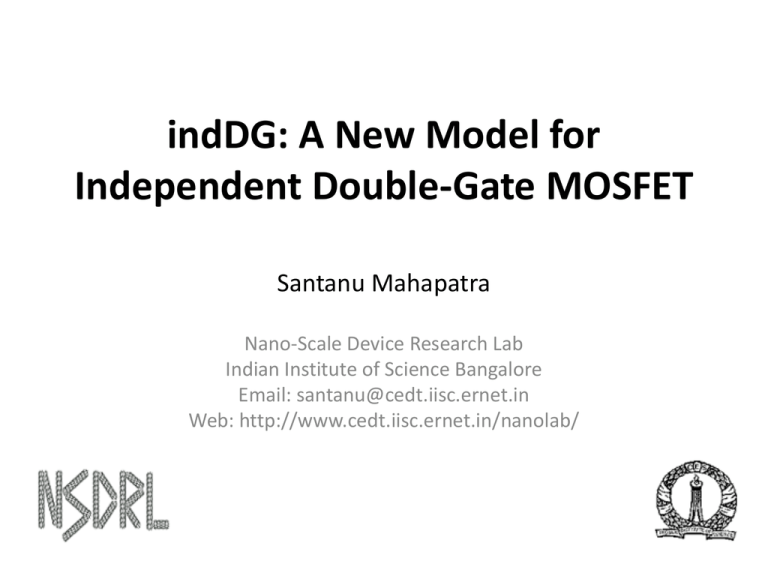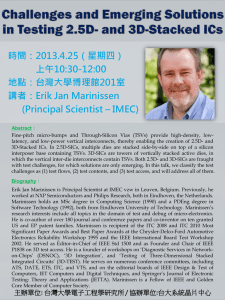indDG: A New Model for Double-Gate MOSFET - MOS-AK
advertisement

indDG: A New Model for
Independent Double-Gate MOSFET
Santanu Mahapatra
Nano-Scale Device Research Lab
Indian Institute of Science Bangalore
Email: santanu@cedt.iisc.ernet.in
Web: http://www.cedt.iisc.ernet.in/nanolab/
Outline
• Common versus Independent double gate
• Development of indDG Core
Single Implicit Equation based IVE
Solution Technique for IVE
Charge Model
• Extension to Tri-Gate
• SPICE Implementation
• Future Works
Common vs Independent DG MOSFET (1)
Courtesy:
Endo et al.
IEEE EDL 2009
Common vs Independent DG MOSFET (2)
With IDG MOSFET the design space gets
extended from 2D to 3D, which leads to novel
circuit design possibilities e.g.,
Vds
Vg1
Vg2
1. High density reduced stack logic, IEEE T-ED
2006
2. Compact sequential circuit, IEEE T-ED 2006
3. Mixer, IEEE T-ED 2005
4. SRAM, IEEE EDL 2009
Dynamic Threshold Voltage Control: Use one gate to drive, other gate to Vth control
reshold
voltageareand
transconductance
dynamically
that
such devices
needed
to conduct transient
and small-signal
β
2
I ds = µ [F (Qi 1s , Qi 1d , 2C
Gsox
) −1 F2C
(Qox
(1)
i 1d2 , Qi 2d , Gd )]
(2)
stoin
a
circuit
simulator.
As
the
terminal
charge
intenovel
circuit
applications
applications
as
demonstrated
L
analysis in a circuit simulator. As the terminal charge inte(2)
annot
be solved
directly,
different
charge
linearization
literatures
[1][4].
An
accurate
compact
model
of
grals cannot be solved directly, different charge linearization
Here
whereQi 1 and Qi 2 are the inversion charge densities of the
Here Q and Qi 2 are the inversion charge densities of the
ues
are
developed
over
the
years
(first
for
bulk
[5]rminal
charges
applicable
for
all
bias
conditions
for
techniques are developed over the years (first for bulk first
[5]-and secondi 1gates given
by 2
first and second
by
then
for
DG
[7]-DG
[9]conduct
MOSFETs)
to approximate
the
Qi 1 2gatesQgiven
2
1
devices
arethen
needed
to
and small-signal
i2
[6] and
for
[7][9]transient
MOSFETs)
to approximate
the
F
(Q
,
Q
,
G)
=
+
+
(Qi 1 + Qi 2 )+ si t si (3)
G
i
1
i
2
ition
along
the
channel
as
a
quadratic
function
of
Q
=
C
V
−
ψ
isthein position
a circuitalong
simulator.
As the terminal
charge integ1(
2)1 2C
1(ox
2)2 β
2C
2
the channel
as a quadratic
function i 1(
of2) Qi 1(ox2)1(=2) Cox
ox
V
−
ψ
(3)
1( 2)
g1( 2)
1( 2)
face
potential
(or
inversion
charge
densities)
so
that
cannot
be
solved
directly,
different
charge
linearization
(2)
the surface potential (or inversion charge densities) so and
thatG, the coupling factor is expressed as [11]
minal
charges
can
be
expressed
as
a
compact
closed
G, the coupling factor is expressed as [11]
ques
are
developed
over
the
years
(first
for
bulk
[5]the terminal charges can be expressed as a compact closed and
2
Here Q
Qi i11 and Q2βi (2ψ 1are
the inversion
charge densities of the
unction
of DG
source
drain
surface
potentials
Qi 2 2
dform
then function
for
[7][9] MOSFETs)
to
approximate
the
−V)
of and
source
andend
drain
end surface
potentials
Q
QBi 2e2β ( ψ 2 − V β) ( ψ2 − V )
i1
G
=
−
B
e
=
−
(4)
β
(
ψ
−
V
)
1
2
2 =
first
and
second
gates
given
by
ersion
charge
densities).
In
this
work
we
show
that
G
=
−
B
e
−
B
e
(4)
osition
along
the
channel
as
a
quadratic
function
of
2
2
(or inversion charge densities). In this work we show that si
si
si
Previous
solution (Taur, andsi then Gildenblat)
urface potential (or inversion charge densities) so that
Q
=
C
(3)
workThis
is funded
by
the
Indo-French
Centre
for
the
Promotion
i 1( 2)
ox 1( 2) Vg1( 2) − ψ1( 2)
work is funded
byexpressed
the Indo-French
Centre forclosed
the Promotion
rminal
charges
can beunder
asnumber:
a compact
t
2θy
nced
Research
(IFCPAR)
the
grant
4300-IT-1.
J.
Si
ONt Si
DEVICES
of Advanced Research (IFCPAR) under the grant number: 4300-IT-1.
J. = V −IEEE
ψ (y)
2UTRANSACTIONS
sin
{ELECTRON
h} sinα{ +
σ α + σ 2θy
(5)
T ln
of
source
and
drain
end
surface
potentials
a,function
A.
Abraham
and
S.
Mahapatra
are
with
the
Nano
scale
deψ
(y)
=
V
−
2U
ln
h}
(5)
and
G,
the
coupling
factor
is
expressed
as
[11]
Srivatsava, A. Abraham and S. Mahapatra are with the Nano scale de4LT d θ 4L θ
t Si
t
earch
Laboratory,
Department
of
Electronic
Systems
Engineerd
Si
version
chargeLaboratory,
densities).
In this of
work
we show
thatEngineervice Research
Department
Electronic
Systems
2
2
merly
CEDT), Indian
science,
C.
ing (formerly
CEDT),Institute
Indian of
Institute
of Bangalore-560012.
science, Bangalore-560012.
C. QHere
Qi 2oxide
i1
β1(
( ψ2)1 − V
) the
β ( ψ2 − V )
C
are
capacitance
per unit
ox
s Anghel
with theis Institut
Superieur
d’Electronique
de
Paris
(ISEP),
21
G 21
=− V2 − Bte sin { h} =(α −2 σθ)
− Be
(4)area of
with the
Superieur d’Electronique
Paris (ISEP),
work is funded
by Institut
the Indo-French
Centre for the dePromotion
V
g1
Si
Assas,
75270,
France.
emails: {srivatsava,
abraham abraham
sanfirst(second)-gate
defined
as − ox
/t1 σθ
is−the
si (α
siTRANSACTIONS
siDEVICES
ox 1(cot
2) , { C
ON ELECTRON
rue deResearch
Assas,Paris,
75270,
Paris,
emails:
{srivatsava,
san- IEEE
+ ln
2r
h}
σθ)silicon
= 0
anced
(IFCPAR)
underFrance.
the grant
number:
4300-IT-1. J.
SDG
device
has
symmetric
BC,
that
leads
to
dt.iisc.ernet.in,
costin.anghel @isep.fr @isep.fr
2UT body capacitance
4L dper unit area defined as si /t si , si , ox
tanu}@cedt.iisc.ernet.in,
va,
A. Abraham and S. costin.anghel
Mahapatra are with the Nano scale deVs2 −implied
V
t Si
{ h} (α + σθ)
additional
BCsin(electric
field− =0
at y=0),
esearch Laboratory, Department of Electronic Systems Engineer+ ln
2r 2 σθ cot
(6) { h}
QS(α
= +− (σ
rmerly CEDT), Indian Institute of science, Bangalore-560012. C.
Vg2which
− V results
t SiT sinin
{ h}very
(α + simple
σθ)4L d trigonometric
2U
IVE
+ ln
− 2r 2 σθcot { h} (α + σθ) = 0
is with the Institut Superieur d’Electronique de Paris (ISEP), 21
where Q
2U
4L
T
d
Assas, 75270, Paris, France. emails: {srivatsava, abraham sancedt.iisc.ernet.in, costin.anghel @isep.fr
(5)Qi 1 + Qi
Vs2 − V
t Si sin { h} (α + σθ)
Development of indDG Core
Single Implicit Equation Based IVE (1)
− 2r 2 σθcot { h} (α + σθ) = available,
0
beenr 2(
prop
r(7)
S+ 1
1( 2)
1)
V2( 1) cr = Vg1( 2) − 2UT ln
− 4UT
+ quadra
as
S− 1
S− 1 S+ 1
closed fo
However
r 1( 2)
r 2( 1)
S+ 1
V2( 1) cr = Vg1( 2) − 2UT ln
− 4UT
+
earization
S− 1
S− 1 S+ 1
function o
2r 1( 2)
(8)
change lin
S = 1+
r 1( 2) t S i
Vs 1 ( 2 ) − V
potentials
W
exp
2L d
2U T
bias cond
2r 1( 2)
S = 1 +Here r Coxt 1( 2) areV the− Voxide capacitance per
(9) unit
area
1. When
1( 2) S i
s 1( 2)
W
exp
2L d
2U T
first(second)-gate
defined
as ox /t ox 1( 2) , Csi is distributio
the silic
unit areaperdefined
as ofsi /t sithe
, chann
Here Cbody
are the oxideper
capacitance
unit area
si ,
ox 1( 2) capacitance
2UT
A Very Complex Problem
Requires Solution of COUPLED
implicit equations which has
DISCONTINUITY!!
+ ln
4L d
the center of the Si film. Vgs1(2) represents the first (second)
effective gate voltage, i.e., Vgs1(2) = Vgs1(2)applied − Φ1(2) ,
where Φ1(2) is the work function difference at the respective
gates. We ignore the hole concentration, and hence, the PE is
valid for ψ > 3/ β. By integrating the PE once using BC1 at the
lower
bound, we
get
Single
Implicit
Equation Based IVE (2)
Development of indDG Core
dψ
dy
ψ
By indigenous handling of BC, we− (β
introduced
single implicit equation based IVE
V)
dψ
dψ
qni e
that is 5x fasterd than coupled
= IVE.
e(βψ) dψ.
dy
dy
Si
dψ
− t Si
ψ
d y |y = − t Si
2
2 COMPUTATIONALLY EFFICIENT GENERALIZED POISSON SOLUTION FOR IDG TRANSISTORS
SAHOO et al.:
(4)
635
Equation (4) results in
dψ
= ±
dy
Aeβψ + G1
(5)
where A = 2qni e(− βV ) / β Si , and G1 = { dψ/ dy|y= − t Si / 2 } 2 −
Ae(βψ1 ) Now, if we use BC2 instead of BC1 at the lower bound
of (4), we
get et
another
form
of Velectric
Sahoo
al., IEEE
T-ED,
57, N 3,field,
2010which is
Fig. 2. Validation of the continuity of the proposed model over the gate
voltage variation. Here, the line represents the model, and the symbol represents
numerical simulations. To the left side of the Vgs2 = 0.5βψ
V line, Vgs1 < Vgs2 ,
and hence, ψgzp = ψgzp 2 . To the right side of the Vgs2 = 0.5 V line,2Vgs1 >
Vgs2 , and hence, ψgzp = ψgzp 1 . Similarly, Vgscr i t is Vgs1cr i t to the left of the
dψ
= ±
dy
Ae
+G
Fig. 4. Ratio of the computational times between the previous model [1]
and the proposed model for an asymmetric DG transistor with the following
device parameters: t ox 1 = 1.5 nm; t ox 2 = 1.5 nm; t si = 10 nm; ∆ Φ1 =
− 0.56 V; and ∆ Φ2 = 0.56 V. The characteristic is almost independent of the
values of V .
(6)
undoped
bulkconcept
MOSFET
as proposed
Shangguan
[5].
has
to use the
of the
GZP and by
critical
voltageettoal.
select
In
Fig.
1(a),
G
is
plotted
as
a
function
of
the
interface
po1
the exact form from the chosen set as discussed in the next
tential
ψ
for
two
different
values
of
V
.
The
circles
represent
1
gs1
paragraph. Finally, one should solve the corresponding implicit
the values
of ψ1 obtained
or (12)
for different
Vgs2 ’s
equation
(11)–(14),
i.e., onlyfrom
one (11)
implicit
equation
at any given
(≤
V
),
and
they
increase
with
increasing
V
.
To
choose
the
gs1
gs2
bias, for the calculation of the potential profile. As (7) and (8)
correct
form
between
(7)
and
(8),
one
has
to
determine
whether
[and similarly (9) and (10)] were derived on the basis of the sign
the correct ψ1 for the given bias lies to the left or the right
of G, the GZP plays
a major role in determining the final form
side of ψgzp1 , i.e., whether it lies in the positive or negative
of the solution.
The GZP is that interface potential at which
G1 region. ψ1 shifts toward the negative G1 region [where (8)
G becomes
zero. Hence, we can have two GZPs, depending
holds] when one increases V because the opposing electric
on which G we choose in thegs2
first step. For example, if one
field from the second gate increases the possibility of having a
chooses (7) or (8) in the first step, then one should use the GZP
minima of ψ(y) inside the Si film. Thus, we introduce a term
corresponding
G1 denoted
ψgzp1 ; otherwise, one should
called criticaltovoltage
(Vgscrby
i t ), which is that Vgs2 at which
use
ψ
.
Equating
G
to
zero
and solving
for to
theψinterface
gzp2
1(
2)
ψ1 obtained from (11) or (12) becomes
equal
gzp1 . One
potential
ψ
,
we
get
the
explicit
formulation
for
the GZP
as
1(
2)
can derive the expression for the Vgs2cr i t by applying
the limit
follows:
G1 → 0 to (11) and (12) and then replacing ψ1 by ψgzp1 and
Fig. 1. (a) GZP and critical voltage at V = 0. (b) Variation of ψgzp 1 and
Vgs2cr i t , with quasi-Fermi level V for the same parameters at Vgs21 = 0.4 V.
Development of indDG Core
G1( 2) → 0, (7)–(10) merge to the following limit values:
√
− β ψ1
−2
β A
t Si
lim ψ(y) =
ln e 2 +
y+
(17)
G 1→ 0
β
2
2
√
− β ψ2
−2
β A
t Si
lim ψ(y) =
ln e 2 +
−y+
. (18)
G 2→ 0
β
2
2
Solution technique for IVE (1)
β V g s1 ( 2 )
Vgs2 by Vgs2cr i t . Similarly,
Aε2Si by applying
2
βVgs1cr i t2 can be derived
ψ
V2gs1(
W and
e (14) and then2 replacing
. ψ
(15)
the
limit
→2)0−to (13)
gzp1(
2) =G
2 by
β
2
Cox1( 2)
ψgzp2 and Vgs1 by Vgs1cr i t as follows:
Equations (17) and (18) prove the continuity of the model
between (7)–(10), respectively. Again, when dψ/ dy → 0, ψ
becomes ψ1 as per (7) and (8). Similarly, ψ becomes ψ2 as
per (9) and (10) when dψ/ dy → 0, but ψ2 = ψ1 at dψ/ dy = 0.
Therefore, the proposed model is also continuous between the
G1 and G2 forms. It is worth noting that the previous works
[1]–[3] use two different forms (hyperbolic and trigonometric)
to model ψ(y). A similar critical voltage concept has been
used in the models [1], [3] to choose between the two forms.
However, the formulation for critical voltage is implicit in
their work, whereas it is explicit in this work. There are some
similarities between the solution techniques used in this work
Fig.
1. the
(a) GZP
critical voltage
at VHowever,
= 0. (b) Variation
of ψgzp 1 work
and
and
workandreported
in [5].
the previous
Vgs2cr
,
with
quasi-Fermi
level
V
for
the
same
parameters
at
V
=
0.4
gs21
i
t
uses only trigonometric forms and, thus, is not valid underV.all
conditions. The same group has also proposed a surface
Gbias
1( 2) → 0, (7)–(10) merge to the following limit values:
potential equation (not the full Poisson
solution) that uses a
√
− β ψ1
single implicit− equation
[6]. Asβin A
their other
2
t Si work, it is also
2 +
lim ψ(y) =
ln e forms
y +valid under all(17)
based
and2 is not
bias
G 1 → 0 on trigonometric
β
2
conditions.
√
− β ψ2
−2
β A
t Si
lim ψ(y) =
ln e 2 +
−y +
. (18)
G 2→ 0
β
2
2
III. R ESULTS AND D ISCUSSIONS
Here, W represents the √ Lambert function. Interestingly,
ψ gzp 1( 2)
−2
β equal
At Sito the− βsurface
ψV
potential of an
gzp1(
2) is approximately
2
ln
+ e
gs2( 1) cr i t =
β
2
undoped bulk MOSFET as proposed by Shangguan et al. [5].
In Fig. 1(a), G1 is plotted as a function of the interface po√ . The circles represent
tential ψ1 for two different values of Vgs1
εor
A for different V ’s
Si (12)
the values of ψ1 obtained
− from (11)
. gs2(16)
√
− β ψ gzp 1( 2)
β
A t Si
(≤ Vgs1 ), and they increase
with
increasing
V
.
To
choose
the
gs2
2
Cox2( 1)
+ e
2
correct form between (7) and (8), one has to determine whether
the correct ψ1 for the given bias lies to the left or the right
Therefore, for V 1) > Vgs2( 1) cr i t , one has to choose the
side of ψgzp1 , i.e., gs2(
whether it lies in the positive or negative
G1( 2) < 0 form, i.e., (8) or (10), otherwise, one has to choose
Gbetween
region.
ψ
shifts
toward the negative G region [where (8)
1
(7)1and (9). In Fig. 1(b), we have1 shown the variation
holds]
when
one
increases
Vgs2 because
opposinglevel
electric
of ψgzp and Vgscr i t as a function
of the the
quasi-Fermi
(V ),
field
from
the
second
gate
increases
the
possibility
of
having
a
and both of these quantities are found to be saturated at a high
minima
of ψ(y)
inside
thesquare
Si film.
Thus,
V as they
depend
on the
root
of A.we introduce a term
called
critical
voltage
(V
),
which
that Vgs2 of
at the
which
gscr
it
and
(18)validated
prove the
of the
model
Now, coming to the question of theiscontinuity
pro- Equations
In Figs.(17)
2 and
3, we
our continuity
model against
a numerical
ψposed
from
(11)
or
(12)
becomes
equal
to
ψ
1 obtained
gzp1
model between various forms, we notice that. One
when between
simulation
for V respectively.
= 0. The numerical
solution
(7)–(10),
Again, when
dψ/ of
dy the
→ 0,PEψis
can derive the expression for the Vgs2cr it by applying the limit becomes ψ as per (7) and (8). Similarly, ψ becomes ψ as
1
2
G1 →
0 to (11) and (12) and then replacing ψ1 by ψgzp1 and peron(9)
and04,2010
(10) when
dψ/EST
dy →
butXplore.
ψ2 = Restrictions
ψ1 at dψ/apply.
dy = 0.
Authorized licensed use limited to: INDIAN INSTITUTE OF SCIENCE. Downloaded
March
at 21:12:31
from0,
IEEE
Vgs2 by Vgs2cr it . Similarly, Vgs1cr it can be derived by applying Therefore, the proposed model is also continuous between the
the limit G2 → 0 to (13) and (14) and then replacing ψ2 by G and G forms. It is worth noting that the previous works
1
2
ψgzp2 and Vgs1 by Vgs1cr it as follows:
[1]–[3] use two different forms (hyperbolic and trigonometric)
Singularity @ γ = π
for Trig IVE
Vgs2( 1) cr it =
Discontinuity @ G = 0 for
√
both
Trig
−2
β At and Hyp IVE
β
ln
Si
2
+ e
− β ψ g zp 1 ( 2 )
2
Conventional NR
method doesn’t
GUARANTEE
convergence!!
to model ψ(y). A similar critical voltage concept has been
used in the models [1], [3] to choose between the two forms.
However, the formulation for critical voltage is implicit in
their work, whereas it is explicit in this work. There are some
Development of indDG Core
Solution technique for IVE (1)
• We use RBM (Root Bracketing Method) instead of NR-based method to achieve
guaranteed convergence.
• We did a rigorous study of all RBMs available in the literatures (~20). And finally
choose LZ4 technique (D. Le, ACM T-MS 1985) to solve the IVEs.
But RBM requires solution space….
So we need to solve ONE more implicit equation, to find the
solution space for Trig/Hyp IVE. We do some smart optimization
of solution space to improve overall computational efficiency.
And so we need to solve THREE implicit equations SEQUENCIALLY
(one to choose mode, one to find solution space and finally the
main IVE) to calculate the surface potential.
Srivatsava et al., IEEE T-ED, V 58, N 6, 2011
Abraham et al., IEEE T-ED, April, 2012
Development of indDG Core
THREE MODES OF OPERATION
The Charge Model : Issues with existing Model
T
T
HH
TH
Line: Model (G. Dessai, IEEE T-ED 2010)
Symbol : Numerical
Development of indDG Core
The Charge Model: Charge linearization Concept
As the exact solution of the integrals are not available ‘charge linearization’
techniques are introduced over the years to approximate F as quadratic function of
surface potentials (or charge densities) so that closed form expressions for terminal
charges are obtained.
Development of indDG Core
The Charge Model : The NLF Factor
To approximate F as quadratic function of ψ1 or ψ2
(Qi1 or Qi2 ), they should hold linear-relationship
along the channel for a given bias condition.
Development of indDG Core
The Charge Model: Piecewise Linearization Technique
We segment the channel, so that for each segment ψ1 holds linear
relationship with ψ2 so that conventional charge linearization technique
could be applied to formulate the Terminal Charges.
Srivatsava et al., Appearing in IEEE T-ED, 2012
Development of indDG Core
The Charge Model: Comparison of linearization
• indDG charge model is
based on the
relationship of the
surface potentials
• It is derivative free and
thus numerically
robust
SDG with small Tox asymmetry (indDG-c)
• There will always be some amount of asymmetry between the gate oxide
thicknesses due to process variation and uncertainties
• indDG-c handles the asymmetry as it is based on the relationship between
surface potential (which is linear for this case)
• We use an accurate analytical approximation of surface potential by novel
perturbation technique
Simple closed form function of Bias and
device parameters, derived from the IDG IVEs
Srivatsava et al., IEEE T-ED, April, 2012
Including Body Doping
Tox1=1nm Tox2=1.5nm Tsi = 10nm
Tox1=Tox2=1nm; Tsi = 20nm
Tri Gate Extension
• Tri Gate MOSFET cannot be model like Bulk or DG as the 3D Poisson Equation
cannot be approximated as 1D Poisson for long channel cases.
• Models for Tri Gate are developed on top of the planner DG Models
Model Implementation
Model is implemented in Silvaco SmartSpice through Verilog-A interface
S/D Symmetry of Terminal Charge
101 Stage Ring Oscillator
Also successfully simulated 8-bit Ripple carry adder, Jhonson Counter
Future Plans
To include Small geometry effects, NQS, Noise, extrinsic elements to make
it applicable for practical devices…
Acknowledgement
My Masters and Ph.D. students
Department of Science and Technology (DST), Government of India
Dr. Ivan Pesic and his team @ Silvaco International






